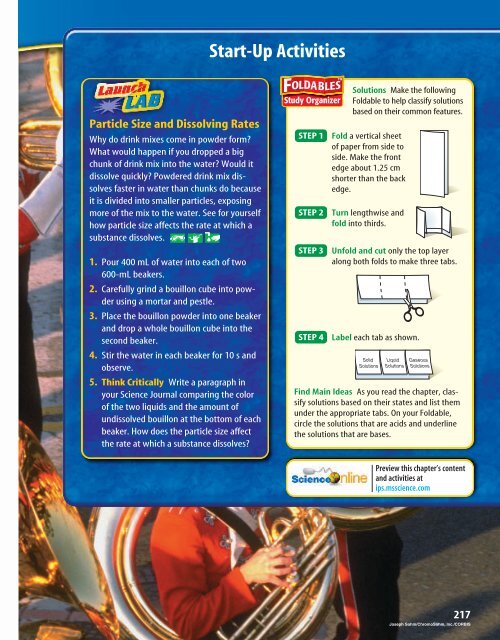Substances, Mixtures, and Solubility - McGraw-Hill Higher Education
Substances, Mixtures, and Solubility - McGraw-Hill Higher Education
Substances, Mixtures, and Solubility - McGraw-Hill Higher Education
Create successful ePaper yourself
Turn your PDF publications into a flip-book with our unique Google optimized e-Paper software.
Start-Up Activities<br />
Particle Size <strong>and</strong> Dissolving Rates<br />
Why do drink mixes come in powder form<br />
What would happen if you dropped a big<br />
chunk of drink mix into the water Would it<br />
dissolve quickly Powdered drink mix dissolves<br />
faster in water than chunks do because<br />
it is divided into smaller particles, exposing<br />
more of the mix to the water. See for yourself<br />
how particle size affects the rate at which a<br />
substance dissolves.<br />
1. Pour 400 mL of water into each of two<br />
600-mL beakers.<br />
2. Carefully grind a bouillon cube into powder<br />
using a mortar <strong>and</strong> pestle.<br />
3. Place the bouillon powder into one beaker<br />
<strong>and</strong> drop a whole bouillon cube into the<br />
second beaker.<br />
4. Stir the water in each beaker for 10 s <strong>and</strong><br />
observe.<br />
5. Think Critically Write a paragraph in<br />
your Science Journal comparing the color<br />
of the two liquids <strong>and</strong> the amount of<br />
undissolved bouillon at the bottom of each<br />
beaker. How does the particle size affect<br />
the rate at which a substance dissolves<br />
STEP 1<br />
STEP 2<br />
STEP 3<br />
STEP 4<br />
Solutions Make the following<br />
Foldable to help classify solutions<br />
based on their common features.<br />
Fold a vertical sheet<br />
of paper from side to<br />
side. Make the front<br />
edge about 1.25 cm<br />
shorter than the back<br />
edge.<br />
Turn lengthwise <strong>and</strong><br />
fold into thirds.<br />
Unfold <strong>and</strong> cut only the top layer<br />
along both folds to make three tabs.<br />
Label each tab as shown.<br />
Solid<br />
Solutions<br />
Liquid<br />
Solutions<br />
Gaseous<br />
Solutions<br />
Find Main Ideas As you read the chapter, classify<br />
solutions based on their states <strong>and</strong> list them<br />
under the appropriate tabs. On your Foldable,<br />
circle the solutions that are acids <strong>and</strong> underline<br />
the solutions that are bases.<br />
Preview this chapter’s content<br />
<strong>and</strong> activities at<br />
ips.msscience.com<br />
217<br />
Joseph Sohm/ChromoSohm, Inc./CORBIS

















